Join the many companies that staff their roles with our machine learning engineers
Our machine learning engineers are ready to be hired
Aisha R.
- Austin, TX
- 2 years of experience
Improved model accuracy by 27% through feature engineering and hyperparameter tuning on a customer churn prediction project.
Reduced inference time by 40% by optimizing a deep learning model for edge devices, resulting in successful deployment on 100,000+ IoT sensors.
Collaborated with cross-functional teams to integrate machine learning models into production systems, ensuring seamless deployment and monitoring.
Recent Project
Developed a computer vision system for autonomous drones in agriculture. The system uses convolutional neural networks to detect crop diseases and estimate yield. This project increased crop monitoring efficiency by 60% and is currently being tested on five large farms across the Midwest.
Marcus L.
- Seattle, WA
- 2 years of experience
Developed a recommendation engine that increased user engagement by 35% and boosted revenue by $2.5 million annually.
Trained and deployed 15 machine learning models using AWS SageMaker, reducing infrastructure costs by 22%.
Mentored junior data scientists and engineers, fostering a culture of knowledge sharing and continuous learning within the team.
Recent Project
Created an NLP-based sentiment analysis tool for a major social media platform. The tool processes millions of posts daily to detect emerging trends and potential crises. It has been crucial in helping the platform respond to user concerns 75% faster than before implementation.
Elena K.
- Boston, MA
- 12 years of experience
Implemented a fraud detection system using ensemble methods, resulting in a 92% reduction in false positives and saving the company $5 million annually.
Optimized data pipelines, reducing processing time by 60% and enabling real-time model updates for 50 million daily active users.
Led the adoption of MLOps best practices, including version control for models and automated testing, significantly improving team productivity and model reliability.
Recent Project
Designed a reinforcement learning algorithm for optimizing energy consumption in smart buildings. The system learns from occupant behavior and environmental factors to adjust HVAC settings dynamically. Initial tests show a 25% reduction in energy usage without compromising comfort levels.
Raj S.
- Chicago, IL
- 3 years of experience
Developed a time series forecasting model that improved inventory management accuracy by 40%, leading to a $3.2 million reduction in carrying costs.
Increased model interpretability by implementing SHAP values, resulting in 28% higher stakeholder buy-in for ML-driven decisions.
Spearheaded the transition to a microservices architecture for ML models, enhancing scalability and reducing deployment time from weeks to hours.
Recent Project
Built a multi-modal machine learning system for medical diagnosis assistance. The system combines image analysis of X-rays and CT scans with natural language processing of patient records. In preliminary tests, it has shown a 15% improvement in early detection rates for certain conditions compared to traditional methods.
Olivia T.
- Miami, FL
- 10 years of experience
Created an anomaly detection system for IoT devices, reducing false alarms by 85% and improving overall system reliability by 30%.
Increased model training speed by 3x through the implementation of distributed computing techniques on a cluster of 50 GPUs.
Pioneered the use of explainable AI techniques within the organization, enhancing transparency and trust in machine learning models across various departments.
Recent Project
Developed a generative AI model for creating personalized workout plans. The model takes into account user preferences, fitness levels, and health data to generate tailored exercise routines. Early adopters report a 40% increase in workout adherence and satisfaction compared to generic plans.
Nexus IT Group will quickly staff your technical roles
81%
of our successful candidates are submitted within one week
92%
of our candidates will accept your offer
96%
of our candidates are employed with your firm after 12 months
What our clients have said about working with Nexus IT Group
Our client creates balance between existing investments and cloud-driven innovation with a practical approach that prioritizes results. This particular client tasked our cloud recruiters with a challenging project. Being named Google Cloud Partner of the Year, this recognition required them to increase their Google Cloud Architect and Engineering resources. Google Cloud talent is quite a bit more scarce than AWS and demand more salary, so our cloud recruiters had to get creative with our sourcing strategy. Reach out to learn how we filled 13 Google Cloud professionals for this client.


A 3 year old startup who is transforming insurance buying by providing a digital insurance engine and world-class underwriting capabilities tasked Nexus IT group to identify, vet, and hire a Head of Data Engineering for the data engineering group. Our data scientist recruiters quickly got on this executive level search. Diversity sourcing and hiring was very important for this client so the team focused on diversity sourcing. We ended up sourcing 176 candidates, submitted six candidates and the client ended up hiring one candidate.


Our client creates balance between existing investments and cloud-driven innovation with a practical approach that prioritizes results. This particular client tasked our cloud recruiters with a challenging project. Being named Google Cloud Partner of the Year, this recognition required them to increase their Google Cloud Architect and Engineering resources. Google Cloud talent is quite a bit more scarce than AWS and demand more salary, so our cloud recruiters had to get creative with our sourcing strategy. Reach out to learn how we filled 13 Google Cloud professionals for this client.


Our client creates balance between existing investments and cloud-driven innovation with a practical approach that prioritizes results. This particular client tasked our cloud recruiters with a challenging project. Being named Google Cloud Partner of the Year, this recognition required them to increase their Google Cloud Architect and Engineering resources. Google Cloud talent is quite a bit more scarce than AWS and demand more salary, so our cloud recruiters had to get creative with our sourcing strategy. Reach out to learn how we filled 13 Google Cloud professionals for this client.
Frequently asked questions about hiring your next machine learning engineer
Typically, a strong candidate will have a degree in Computer Science, Mathematics, or a related field, with a focus on machine learning. Look for experience with popular ML frameworks, programming skills (especially Python), and a solid understanding of statistics and algorithms.
While there’s overlap, Machine Learning Engineers focus more on building and deploying ML systems at scale. They often have stronger software engineering skills and are more involved in the production side of ML models, whereas Data Scientists may focus more on analysis and model development.
Python is essential. Other valuable languages include R, Java, and C++. Familiarity with SQL for database management is also important. The specific requirements may vary based on your tech stack.
Key frameworks include TensorFlow, PyTorch, and scikit-learn. Familiarity with cloud platforms like AWS, Google Cloud, or Azure is often necessary. Knowledge of version control systems (like Git) and containerization (like Docker) is also valuable.
Consider a mix of theoretical questions about ML algorithms and practical coding challenges. Ask them to explain a past project in detail, focusing on their role, challenges faced, and solutions implemented. You might also present a hypothetical ML problem and discuss how they would approach it.
Yes, experience with big data technologies like Hadoop, Spark, or Kafka is often beneficial, especially for roles dealing with large-scale data processing and model deployment.
While not always essential, domain knowledge can be very valuable. It helps in feature engineering, understanding the business impact of models, and communicating effectively with stakeholders. The importance varies depending on your specific industry and projects.
Strong problem-solving skills, attention to detail, and the ability to work in a team are crucial. Good communication skills are also important, as they often need to explain complex concepts to non-technical stakeholders.
Look for candidates who actively participate in the ML community through conferences, online courses, or research papers. Contributions to open-source projects or a record of continuous learning are good indicators.


